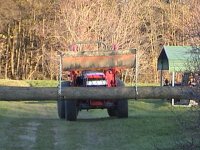If you are talking about more than one log, good hickory can be a very great wood to build furniture, make paneling, or for structural uses and you should go forward with a plan.
However, if it is only one log, it is hardly worth the bother - sawing, stacking to air dry, getting a pile with enough weight to hold it flat while drying, and then drying it down to a moisture content fit for use indoors. The decisions you have to make when sawing are what thickness (about 1 1/8 green for a dry finished board of 3/4 inches), width of boards you might use (the narrower the better for better flatness), and lengths of boards you might use. Then the log is not large at 15" diameter (draw a 15" diam. circle, and see how many 1 3/8 inch boards you can fit into that circle -remembering that the sawcut will be about 1/4"), so there will not be many boards at the surface that are of the high quality (no branches), as further into the log the original branches will show up as knots. This is not a problem if panelling is the product as the knots will give it character. But not much panelling will come from one small log.
If there is already a mill sawing hickory, they may take your log and include it with theirs (and give you some lumber back). Usually mills don't like individual logs, as they don't know if it is a yard log or a fence row log. They have lots of steel in them which can wipe out a saw.
Sorry if this sounds depressing. For your experience, take it to a sawmill, have it sawn into boards (live sawn will be best), and then stack them for drying (the European way is to live saw and stack back ino the shape of a log). Don't share the lumber as you will have very little to stack.
You will know a lot more about getting boards from logs with your new-found experience. (the next one you find may just end up in your firewood stack quickly or you will take another log to the sawmill to add to your collection of boards)
Beenthere (and enjoyed the experience, but didn't get much wood!)

